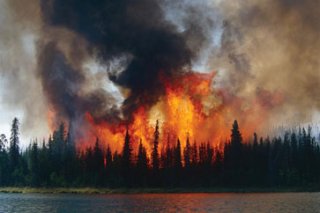Wildfires and Water Quality Research

Wildland fires do not just destroy trees, vegetation, wildlife, and structures that get in their paths. They can also severely affect water quality by causing soil erosion, increased flooding, and the flow of debris and potential contaminants. At the same time, fires can result in the resuspension of legacy mine and industrial waste that has settled in river bottoms.
Research is critical to better understand how fires affect water quality, drinking water sources, and the overall health of an ecosystem. EPA research is filling gaps in our understanding of these issues. In addition, EPA awarded research grants to institutions to study aspects of wildfire impacts to drinking water sources.
Wildfire Impacts on Contaminant Concentrations in Drinking Water
EPA researchers examined post-wildfire effects on drinking water quality by evaluating concentrations and maximum contaminants levels of selected contaminants at public drinking water systems located downstream from wildfire events. The selected contaminants for analysis included nitrate, arsenic, disinfection byproducts (DBPs), and volatile organic compounds.
Results of this research indicate that both surface- and groundwater-sourced drinking water systems can experience significant increases in concentrations and violations for most of the analyzed contaminants post-wildfire. As wildfires become larger and more common due to a changing climate, increased potential for droughts, and more available fuel, system operators may need to be able to adapt their drinking water treatments to their impacted source water. This work may also inform source water management, protection, and contaminant prevention practices to address these wildfire impacts.
Publication (2021): Wildfires can increase regulated nitrate, arsenic, and DBP violations and concentrations in public drinking water supplies
Wildfire Impacts to Drinking Water Sources
Detritus material in forest watersheds is the major terrestrial source of dissolved organic matter (DOM) and DBP precursors in water bodies used as drinking water sources and is also a fuel that can ignite wildfires. In these watersheds, hot temperatures and dry conditions increase the likelihood of high-severity wildfires. To help reduce this risk, low-severity prescribed burning is used as a forest management practice to reduce fuel loads from forest floor detritus material. In either high- or low-severity fires, DOM exported to source waters from managed watersheds is likely to have different characteristics and treatability compared to DOM exported from unburned watersheds.
These potential source water quality changes may require that drinking water utilities adapt their treatment processes to account for these changes. Modeling and decision support tools can help explore treatability and adaptation strategies for these impacted systems.
EPA awarded National Priorities grants to four institutions for research in system-based strategies to improve our Nation’s ability to plan and respond to water scarcity and drought, which includes investigations on surface and ground water quality and availability.
Wildfire Impacts on Drinking Water Quality (Grantee Research)
This field-based research project investigated the consequences of different fuel reduction techniques, typically applied as watershed management practices against wildfire, for the export of dissolved organic carbon (DOC), dissolved organic nitrogen (DON), and inorganic nutrients from forested watersheds as well as the impact of these practices on associated biogeochemical processes and drinking water supplies. Specifically, the temporal variations of DOM exported from forested watersheds under prescribed burn or mechanical thinning were examined and compared with those from unmanaged watersheds to identify differences in the formation of regulated and emerging carbonaceous and nitrogenous disinfection byproducts (DBPs). The overarching goal of this project was to identify the best forest management practices to protect our source waters due to climate change.
Additional information and final report: Fuel reduction techniques as effective forested watershed management practices against wildfire: drinking water quality aspects
Decision Support for Drinking Water Utilities Impacted by Wildfire (Grantee Research)
This research project focused on watersheds’ response to post-fire sedimentation and will provide information on how water utilities can modify treatment plant operations to avoid DBPs. The research included (1) understanding the flow and sediment generation from water supply watersheds in response extreme events; (2) understanding the mobilization and transport of organic matter and sediments through the watershed and eventually to the water treatment plant; (3) developing source water thresholds for turbidity and DBP precursors; and (4) evaluate a suite of adaptation and operation strategies, along with their economic, societal, and policy implications.
Additional information and final report: An Integrated Modeling and Decision Framework to evaluate adaptation strategies for sustainable drinking water utility management under drought and climate change
Additional Resources
Related Research
- EPA wildfire and water quality research publications
- Treatment and control of drinking water contaminants research
- Wildland fire research to protect health and the environment
